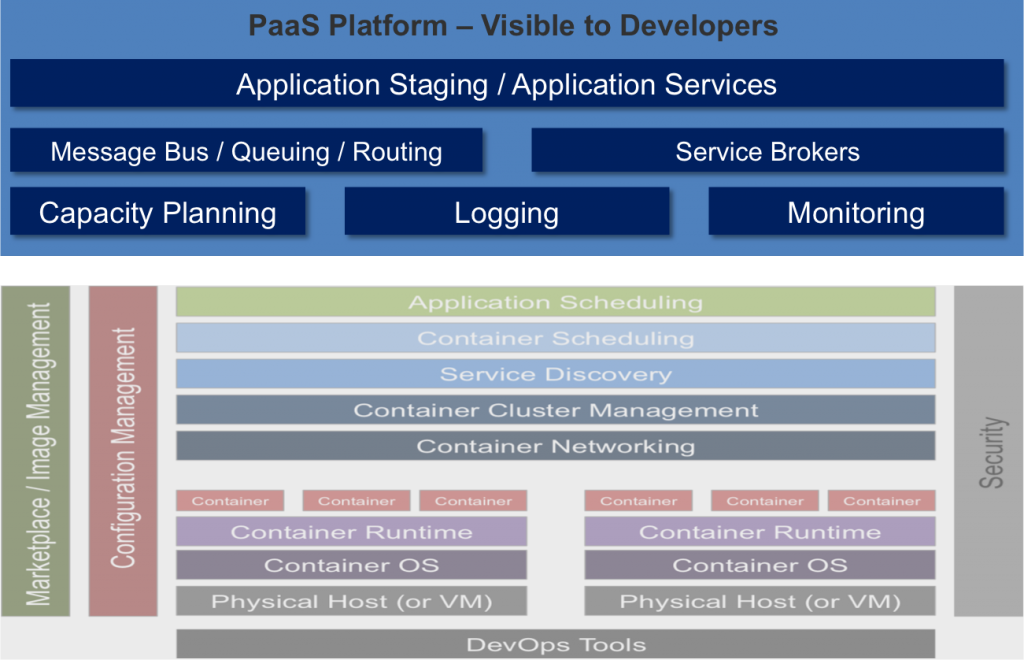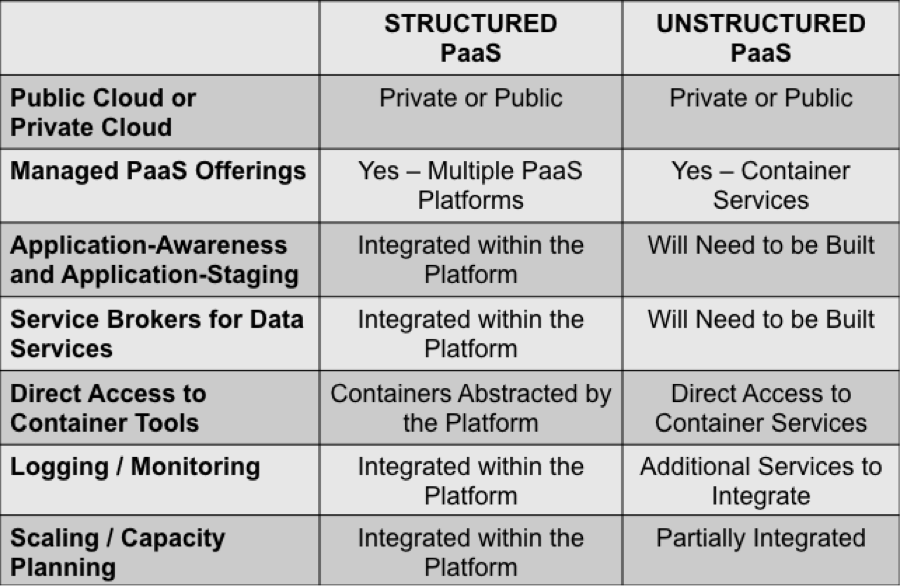Premise: As the Platform (PaaS) market has evolved, two distinct architectural patterns are emerging – Structured and Unstructured. Enterprise businesses will gravitate to Structured platforms, with embedded frameworks for Deployment, Security and Compliance. But will they be able to leverage them fast enough to compete with startups and web-scale companies that prefer the Unstructured platform model?
[In this series of research on Cloud Native Application Platforms, we will explore the Market, Technology, Operations and Organizations that enable next generation applications. Cloud Native applications are the modern, modular approach to building applications that are focused on web-scale, mobile-first, and real-time data.]
Part II of the research – “Technical Dive into Cloud Native Application Platforms”
Part III of the research – “Evolving Organizational Dynamics of Cloud Native Applications”
Since the NIST first released the definitions of Cloud Computing, there have been debates about the accuracy of each of the major categories – Infrastructure (IaaS), Platform (PaaS) and Software (SaaS). As large market offerings have been established over the past five years, the definition debates over IaaS and SaaS have become less frequent. But no category continues to generate as much debate and confusion as Platform-as-a-Service (PaaS), or “Platforms”. Early versions of PaaS platforms struggled to gain broad market adoption for a number of reasons:
- Black Box Operations – Not enough visibility into how the platform was operating, or how to tune the applications within the platform.
- Languages and Frameworks – Limited support for development languages or frameworks. Some platforms only supported a single language.
- Lock-In – Developer concern about cloud-specific lock-in and proprietary APIs.
- Limited Deployment Options – Lack of non-public cloud options scared off industries that have heavy security or compliance requirements.
- Lack of Education – How to build applications that could take advantage of these powerful, scalable platforms?
The lack of maturity of the early PaaS platforms (e.g. Google App Engine, Engine Yard, Heroku, Microsoft Azure) lead to a market fragmentation. While these platforms still exist, the broader PaaS market is quickly shifting to address limitations, customer choice and evolving economics.
Unstructured Platforms
In one camp, many startups and web-scale businesses have decided to build their own platforms from a mix of cloud-provided services and homegrown tools. As these unstructured models evolve, they are beginning to leverage container technologies as the underlying infrastructure. The unstructured technologies are also beginning to work more closely together to move towards a more semi-structured model – as we’ve seen from the charter of the Open Container Initiative (OCI) and Cloud Native Computing Foundation (CNCF).
Companies such as NetFlix, AirBnB, and Pinterest built their application platforms on top of AWS IaaS-level services (EC2, S3, ELB, RDS, EMR), favoring the unstructured UNIX-like tools model. Just like Google, Facebook and Twitter, these companies are reshaping the industries where they compete, and they often have to develop a homegrown set of technologies to manage the scaling challenges their business creates. They rarely have legacy IT applications, and they are aggressively competing for the top engineering talent to drive their growth.
At DockerCon 2015, Battery Ventures VC Adrian Cockcroft (@adrianco) discusses the pace of change in the market and why technology-centric companies (such as NetFlix) have chosen distributed, unstructured architectures to build their next-generation applications.
Structured Platforms
In the other camp, a set of companies and open-source projects have emerged to address the earlier PaaS shortcomings. These structured platforms are focused on eliminating the earlier PaaS problems, as well as simplifying the operational model. VMware created Cloud Foundry and Red Hat created OpenShift. Both of these platforms were created using open source software and supported multiple languages and frameworks (“polyglot”). Cloud Foundry evolved into the Cloud Foundry Foundation, which has attracted over 40+ contributing members (Pivotal, IBM, HP, SAP, Cisco, Verizon, Intel, EMC, VMware, etc.). Apprenda created a platform which focused on Enterprise languages (.NET and Java), and former Cloud Foundry creator Derek Collison started Apcera to focus on advanced Enterprise use-cases.
VC funding has been pouring into these ecosystems over the last 12-18 months:
- Pivotal (Cloud Foundry): $105M in Pivotal via GE in April 2013
- ActiveState/Stackato (Cloud Foundry): Acquired by HP in July 2015
- Apprenda: $56M (total); $24M in July 2015
- Apcera: Undisclosed amount by Ericsson in September 2014
These companies and projects are primarily targeting Enterprise, Government, Mid-Market and Service Provider customers. The platforms are focused on building these new Cloud Native applications, but legacy application integration is a major consideration for their architectural decisions. While these companies are beginning to recruit aggressively for next-generation talent, they are often looking internally to re-train their current staff to help drive their transformations. Companies such as Auto Trader, Capital One, Comcast, ING, JP Morgan, McKesson, Nordstrom, Target have been public in their transformation to these structured platforms.
At Cloud Foundry Summit 2015, Pivotal’s VP/GM James Watters (@wattersjames) and CTO Josh McKenty (@jmckenty) discuss how Structured platforms are growing in popularity with Enterprise and Government customers.
At Red Hat Summit 2015, Apcera Founder/CEO Derek Collison (@derekcollison) focused on how Structured platforms help manage security and compliance for distributed development teams, leveraging platforms that cross multiple clouds.
Before exploring the differences between these Structured and Unstructured architectures, it’s important to step back and look at the critical aspects that IT leaders should consider when evaluating which to select for their Cloud Native applications.


What’s Important in a Platform?
From a business perspective, there are 5 critical considerations:
- How to unlock new business models via technology?
- How to create a digital business platform to increase competitive differentiation?
- How to attract new or improved technical talent to the company?
- How to change the economics of innovation within the company?
- How to better leverage data to make more informed decisions and impact customer experiences
In the 1980s and 1990s, the ERP and supply-chain were the platforms that defined successful companies. In the 2000s, the website and online-ordering where the platforms that allowed companies to compete globally 24x7x365. Going forward, the ability to create new applications and adapt to rapidly changing economics will define the winners and losers in all industries. These Cloud Native platforms will become the differentiator for businesses that want to succeed within their markets. Just within the S&P 500, we’ve seen tremendous change over the past decade for companies that adapted to become more technology-centric:

- How to accelerate the pace of application development?
- How to build modern applications that are better aligned to new technology trends (mobile, social, real-time, data-centric, IoT)?
- How to better leverage open source technologies and communities?
- How to improve operations to be more responsive to changes?
- How is security deeply integrated into the platform?
With so many choices in the market, it’s critical to have alignment between business goals and technology-decision-makers. Instead of measuring the Cloud Native platform based on traditional IT metrics (e.g. cost-reduction), technology teams need to think in terms of business metrics (e.g. time-to-market, market-penetration, customer-satisfaction). Platform vendors, whether they deliver Structured or Unstructured architectures, must be able to clearly show how their technology enables those critical business metrics.
Platform Decision Criteria
For many CIOs, creating a PaaS platform strategy will be a top priority in 2015 and 2016. This strategy is an opportunity to reshape how IT is viewed within the business, and an opportunity to redefine processes that are not aligned to quality and throughput of application delivery. Done correctly, this strategy will create greater alignment between Business and Technology teams and move IT from a cost-reduction center to a revenue-enablement center.
The CIO’s platform strategy should contain the following core elements:
- [Acquisition and Consumption] Build a Platform vs. Buy a Platform vs. Use a Platform (e.g. SaaS)
- [Public Cloud vs. Hybrid Cloud] The ability to integrate local platforms (on-premises) and public platforms.
- [Technical Skills] How to find or develop the technical skills required to build differentiated applications and maintain these new environments (Developers and Operators).
- [Organizational Structure] Transform existing Operational and Organization Models to leverage a more agile platform.
- [Complex Organizations] How to share platform resources across multiple teams.
- [Security and Compliance] How to manage Security and Compliance across multiple teams, and interconnected applications and data.
Action Item: There is no doubt that Cloud Native applications are reshaping every industry. Whether companies build an Unstructured platform, or buy a Structured platform, will be dependent on their ability to apply the correct technical skills and appropriately align their organization for agility. Companies that have not begun the process of evaluating or deploying a platform will quickly find themselves behind their industry peers that are better leveraging software as a core business differentiator.


